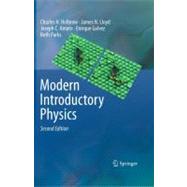Modern Introductory Physics
, by Holbrow, Charles H.; Lloyd, James N.; Amato, Joseph C.; Galvez, Enrique; Parks, M. Elizabeth- ISBN: 9780387790794 | 0387790799
- Cover: Hardcover
- Copyright: 10/2/2010
This is an extensive revision of a successful and innovative introductory text for students of college and university physics. Like the first edition, this revision concentrates on the physics that answers the question: Why do we believe in atoms and their properties? While providing a sound introduction to basic physical concepts, it emphasizes nineteenth- and twentieth-century physics that has led to our modern picture of the atom. The revision also has two new chapters that explore, in the context of real experiments, important ideas of quantum mechanics - including disturbing consequences of superposition such as entanglement, non-locality, and the violation of Bell's inequalities. The book begins with a review of Newtonian mechanics. It then looks at physical evidence that chemical compounds are made of atoms and shows how basic mechanics and a simple hard-sphere model of atoms explain pressure, temperature, viscosity, and the ideal gas laws, and yield the first determination of the size of an atom. Three chapters of basic electricity and magnetism provide tools used to reveal the electrical nature of atoms, to discover the electron, and to identify it as an important part of all atoms. A description of waves and their properties - particularly interference - provides background for chapters describing how the interactions of light, x-rays, and electrons with crystalline matter and with atoms reveal internal structure. After two chapters unfold the discovery of the particle nature of light and the wave behavior of electrons, the puzzle of wave-particle duality emerges. A chapter on radioactivity, transmutation, the discovery of the nucleus, isotopes, and the neutron and a chapter on Bohr's model of the hydrogen atom and Moseley's identification of the atomic number establish the nuclear model of the atom. The final chapters show how the Heisenberg uncertainty principle and Feynman's rules of quantum superposition resolve the issues of wave-particle duality at the cost of some uncomfortably unintuitive ideas. These and experiments that confirm them are described in detail.To help students make a good transition from high-school physics to university physics, this book fosters quantitative skills: There is much use of order-of-magnitude calculations, scaling arguments, proportionalities, approximations, and other basic tools of quantitative reasoning, progressing from simple and direct in the early parts of the book to more elaborate later. There is also a strong effort to show how new physics and new ideas are inferred from experimental data and quantitative reasoning. The book has a large number of problems to help students clarify their understanding. The spreadsheet problems have been updated, and new problems have been added to many chapters. Like most of the problems in the first edition, the new ones are original creations for this book.







